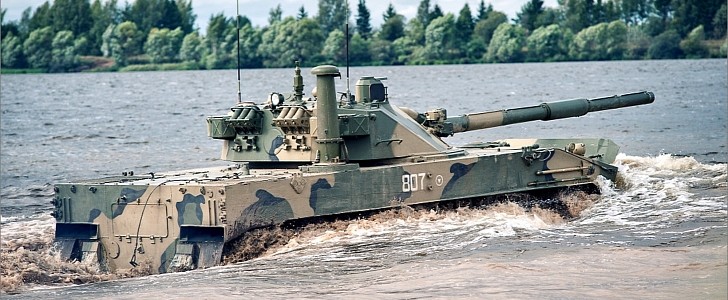It’s almost a cliché to say that Russia knows everything about tanks, but it’s true. Although there are no statistics available, it’s probably safe to say that Russia invests a significant percentage of its military budget in tank development. One of the latest achievements is an upgraded version of its amphibious light tank.
The Eastern military force is currently developing an optimized version of the Sprut-SDM1, a self-propelled anti-tank gun – or a light tank. One of the most important features of this vehicle is that it can be deployed in any kind of environment, during combat, wherever and whenever it’s needed. This is done via airplane or helicopter.
In order to test its strength and resilience, the tank’s manufacturer, the Volgograd Tractor Plant (a KMZ subsidiary), conducted a challenging experiment: the fully-loaded tank was dropped from a tower. No tanks got hurt during this test. Rostec (Russia’s military-industrial complex) officials announced that it was successful, with “no systems affected.”
There are no further details regarding the height of the tower or other factors involved in the experiment. We do know that the Sprut-SDM1 was loaded to maximum capacity before being dropped from the tower, with the purpose of testing its ability to withstand overload, while being deployed from an aircraft.
The manufacturer is currently working on the parachute system for the upgraded Sprut. After that, the tank will undergo drop tests from aircraft, in real-world conditions. The IL-76 and An-124 airlifters, plus the Mi-26 helicopter, will be part of the upcoming tests.
This self-propelled anti-tank gun on a tracked chassis is meant to operate in any climate and on any type of terrain, due to its unique amphibious character. Its 450 HP engine can ramp up to 70 kph (43.4 mph) on land. On water, it can reach a speed of 9 kph (5.6 mph), with a maximum floating time of 7 hours. It’s armed with 125 mm artillery, and equipped with an advanced automated fire control system.
In order to test its strength and resilience, the tank’s manufacturer, the Volgograd Tractor Plant (a KMZ subsidiary), conducted a challenging experiment: the fully-loaded tank was dropped from a tower. No tanks got hurt during this test. Rostec (Russia’s military-industrial complex) officials announced that it was successful, with “no systems affected.”
There are no further details regarding the height of the tower or other factors involved in the experiment. We do know that the Sprut-SDM1 was loaded to maximum capacity before being dropped from the tower, with the purpose of testing its ability to withstand overload, while being deployed from an aircraft.
The manufacturer is currently working on the parachute system for the upgraded Sprut. After that, the tank will undergo drop tests from aircraft, in real-world conditions. The IL-76 and An-124 airlifters, plus the Mi-26 helicopter, will be part of the upcoming tests.
This self-propelled anti-tank gun on a tracked chassis is meant to operate in any climate and on any type of terrain, due to its unique amphibious character. Its 450 HP engine can ramp up to 70 kph (43.4 mph) on land. On water, it can reach a speed of 9 kph (5.6 mph), with a maximum floating time of 7 hours. It’s armed with 125 mm artillery, and equipped with an advanced automated fire control system.









